3-文学翻译解析
- 格式:ppt
- 大小:864.50 KB
- 文档页数:61
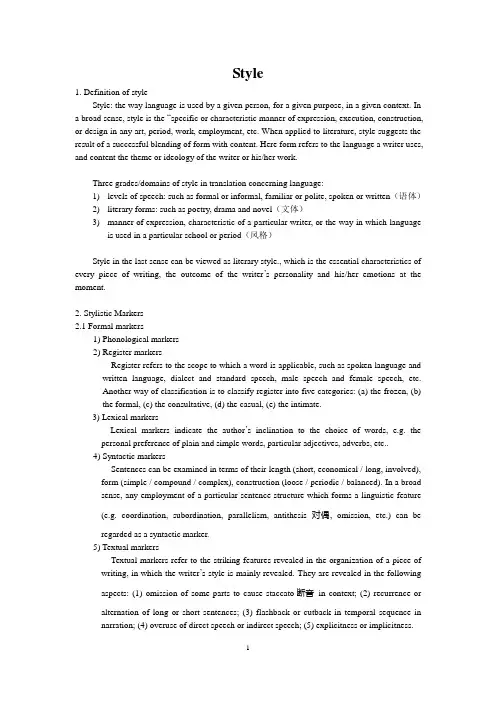
Style1. Definition of styleStyle: the way language is used by a given person, for a given purpose, in a given context. In a broad sense, style is the “specific or characteristic manner of expression, execution, construction, or design in any art, period, work, employment, etc. When applied to literature, style suggests the result of a successful blending of form with content. Here form refers to the language a writer uses, and content the theme or ideology of the writer or his/her work.Three grades/domains of style in translation concerning language:1)levels of speech: such as formal or informal, familiar or polite, spoken or written(语体)2)literary forms: such as poetry, drama and novel(文体)3)manner of expression, characteristic of a particular writer, or the way in which languageis used in a particular school or period(风格)Style in the last sense can be viewed as literary style., which is the essential characteristics of every piece of writing, the outcome of the writer‟s personality and his/her emotions at the moment.2. Stylistic Markers2.1 Formal markers1) Phonological markers2) Register markersRegister refers to the scope to which a word is applicable, such as spoken language and written language, dialect and standard speech, male speech and female speech, etc.Another way of classification is to classify register into five categories: (a) the frozen, (b) the formal, (c) the consultative, (d) the casual, (e) the intimate.3) Lexical markersLexical markers indicate the author‟s inclination to the choice of words, e.g. the personal preference of plain and simple words, particular adjectives, adverbs, etc..4) Syntactic markersSentences can be examined in terms of their length (short, economical / long, involved), form (simple / compound / complex), construction (loose / periodic / balanced). In a broad sense, any employment of a particular sentence structure which forms a linguistic feature(e.g. coordination, subordination, parallelism, antithesis对偶, omission, etc.) can beregarded as a syntactic marker.5) Textual markersTextual markers refer to the striking features revealed in the organization of a piece of writing, in which the writer‟s style is mainly revealed. They are revealed in the following aspects: (1) omission of some parts to cause staccato断音in context; (2) recurrence or alternation of long or short sentences; (3) flashback or cutback in temporal sequence in narration; (4) overuse of direct speech or indirect speech; (5) explicitness or implicitness.6) Markers of figures of speech(修辞格)e.g. Charles Dickens: irony and exaggeration2.2 Non-Formal Markers1) Ways of expressionEvery writer has his / her own way of expressing and processing what he / she writes about, even if they are of the same literary school.e.g. symbolic undertones象征性潜隐叙事法“Near the curb of the crowded sidewalk, pigeons were tossing around a bread crust that someone had dropped or thrown them. They couldn’t cope with it or let it be. These creatures filled me with both compassion for them and rage against their Creator. Where did they spend the nights in this severe weather? They must be cold and hungry. They might die this very night.”It seems that the writer is describing the phenomena in pigeons‟ world, but in fact he refers to the reality of human society. The symbolic meanings exist between and behind the lines, leaving much room for readers‟ exploration.2) Subject mattere.g. Hemingway‟s subject matter is always about death, violence, danger and the like. His preoccupation with individual courage, will and power is unique and characteristic of Hemingway style.3) Ideological Contents3. The difficulty in reproducing the original styleStyle is usually part of the original literary works‟ textual meaning; therefore harm will be done, to a great extent, to the textual meaning of the original, if the translator fails to pay enough attention to the style of the SLT in translation.Owing to the different natures of language, however, which may differ in word formation, syntactic structure, figure of speech, etc., there do exist some linguistic difficulties in stylistic transference. Those who believe style cannot be reproduced insist that style belongs to the category of linguistic form, not content. Form cannot be independent of the concrete mode of expression in the literary text, which has to be changed in the translating process, thus the style is changed accordingly. For example:1)此木为柴山山出,因火成烟夕夕多。
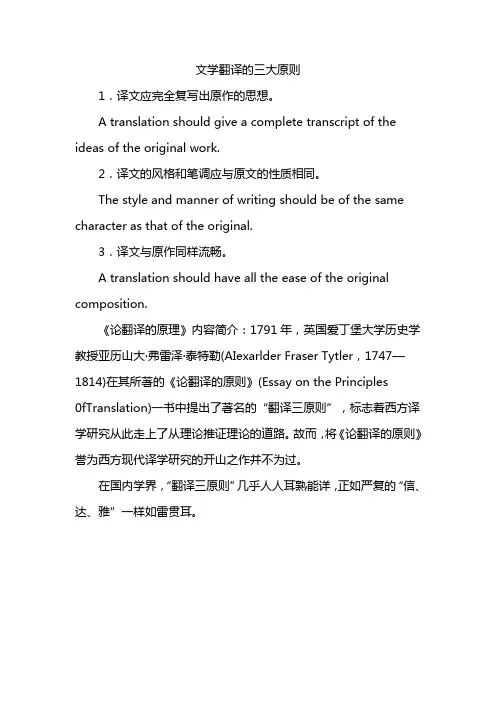
文学翻译的三大原则
1.译文应完全复写出原作的思想。
A translation should give a complete transcript of the ideas of the original work.
2.译文的风格和笔调应与原文的性质相同。
The style and manner of writing should be of the same character as that of the original.
3.译文与原作同样流畅。
A translation should have all the ease of the original composition.
《论翻译的原理》内容简介:1791年,英国爱丁堡大学历史学教授亚历山大·弗雷泽·泰特勒(AIexarlder Fraser Tytler,1747—1814)在其所著的《论翻译的原则》(Essay on the Principles
0fTranslation)一书中提出了著名的“翻译三原则”,标志着西方译学研究从此走上了从理论推证理论的道路。
故而,将《论翻译的原则》誉为西方现代译学研究的开山之作并不为过。
在国内学界,“翻译三原则”几乎人人耳熟能详,正如严复的“信、达、雅”一样如雷贯耳。

寄微之三首其三翻译解析一、任务概述在这篇文章中,将对《寄微之三首其三》进行翻译解析。
该篇诗作是中国古代文学的经典之一,具有深厚的文化内涵。
本文将以翻译解析的方式,逐步探究《寄微之三首其三》的含义、修辞手法以及诗人的意图。
二、原文赏析《寄微之三首其三》原文如下:不负青春曰少年,机心故爱长安天。
长安天上家何在,可上昔时寻北辕。
三、翻译解析1. 翻译诗中第一句”不负青春曰少年,机心故爱长安天”的翻译为:“Do not disappoint your youth, called young, with a heart full of longing for the sky of Chang’an.”第二句“长安天上家何在,可上昔时寻北辕”的翻译为:“Where is home in the sky of Chang’an? Can one find the North Pole of the past?”2. 解析这首诗是对长安的怀念和对过去岁月的追忆之作。
通过对诗句的解析,可以看出诗人对长安这座城市的深情怀念,以及对过去岁月的追忆之情。
第一句“不负青春曰少年,机心故爱长安天”,可以理解为诗人不愿辜负自己的青春,所以怀念长安的岁月。
“青春曰少年”表达了青春的意义,“机心”则表示内心深处的向往和渴望,“长安天”则代表着长安这个城市的美好之处。
第二句”长安天上家何在,可上昔时寻北辕”则表达了诗人对长安的思念之情。
“长安天上家何在”指的是诗人多年离开长安,不再拥有家的归属感,“可上昔时寻北辕”则表示诗人想象着重返过去的岁月,重回到长安。
“寻北辕”是一个比喻性的说法,表示寻找那个再也无法回到的时光。
通过这样的翻译解析,可以更好地理解诗歌的意境,感受诗人的情感和意境。
四、诗歌分析1. 音韵格律这首诗为五言绝句,每一句都是七个字,符合五言绝句的格式。
同时,诗中运用了平仄押韵,使整首诗在音韵上显得流畅而和谐。
2. 主题与意境诗人通过对长安这座城市的怀念,表达了对逝去岁月的追忆之情。
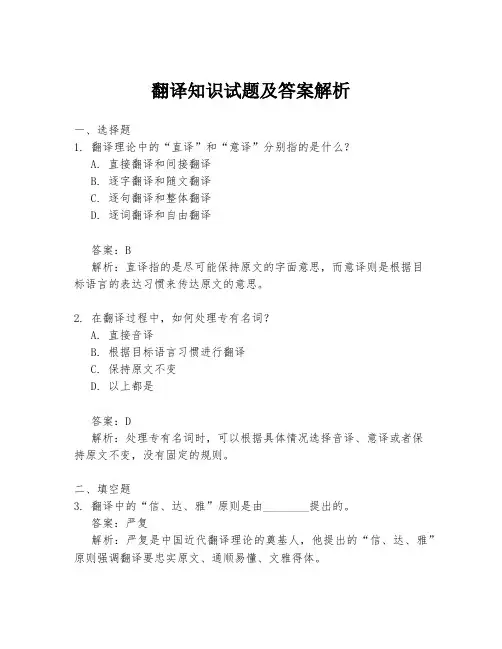
翻译知识试题及答案解析一、选择题1. 翻译理论中的“直译”和“意译”分别指的是什么?A. 直接翻译和间接翻译B. 逐字翻译和随文翻译C. 逐句翻译和整体翻译D. 逐词翻译和自由翻译答案:B解析:直译指的是尽可能保持原文的字面意思,而意译则是根据目标语言的表达习惯来传达原文的意思。
2. 在翻译过程中,如何处理专有名词?A. 直接音译B. 根据目标语言习惯进行翻译C. 保持原文不变D. 以上都是答案:D解析:处理专有名词时,可以根据具体情况选择音译、意译或者保持原文不变,没有固定的规则。
二、填空题3. 翻译中的“信、达、雅”原则是由________提出的。
答案:严复解析:严复是中国近代翻译理论的奠基人,他提出的“信、达、雅”原则强调翻译要忠实原文、通顺易懂、文雅得体。
4. 在翻译文学作品时,译者需要考虑的一个重要因素是________。
答案:文化差异解析:文学作品中往往蕴含丰富的文化内涵,译者在翻译时需要充分考虑文化差异,以确保译文能够传达原作的文化内涵和艺术魅力。
三、简答题5. 简述翻译中“忠实性”的重要性。
答案:忠实性是指翻译时要尽可能保持原文的意思和风格。
忠实性是翻译的基本原则之一,它确保了翻译作品的准确性和可靠性。
在翻译过程中,译者需要忠实于原文的内容、风格和作者的意图,同时也要考虑到目标语言的表达习惯,做到既忠实又通顺。
四、论述题6. 论述翻译中如何处理语言的模糊性和多义性。
答案:语言的模糊性和多义性是翻译中的常见问题。
处理这些问题时,译者首先需要准确理解原文的意图和上下文,然后根据目标语言的表达习惯和文化背景,选择最合适的译文。
在必要时,译者可以采用注释、脚注或者附加解释的方式来帮助读者理解。
此外,译者还应该具备一定的语言敏感性和文化素养,以便更好地处理语言的模糊性和多义性。
五、翻译实践题7. 将以下中文句子翻译成英文,并简要说明翻译策略。
中文句子:他的话让人深思。
英文翻译:His words are thought-provoking.翻译策略:在翻译这句话时,采用了意译的方法。
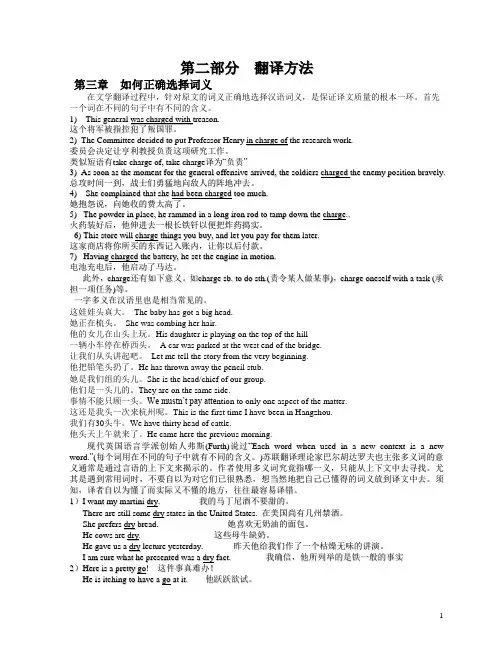
第二部分翻译方法第三章如何正确选择词义在文学翻译过程中,针对原文的词义正确地选择汉语词义,是保证译文质量的根本一环。
首先一个词在不同的句子中有不同的含义。
1)T h i s g e n e r a l w a s c h a r g e d w i t h t r e a s o n.这个将军被指控犯了叛国罪。
2)T h e C o m m i t t e e d e c i d e d t o p u t P r o f e s s o r H e n r y i n c h a r g e o f t h e r e s e a r c h w o r k.委员会决定让亨利教授负责这项研究工作。
类似短语有t a k e c h a r g e o f,t a k e c h a r g e译为“负责”3)A s s o o n a s t h e m o m e n t f o r t h e g e n e r a l o f f e n s i v e a r r i v e d,t h e s o l d i e r s c h a r g e d t h e e n e m y p o s i t i o n b r a v e l y.总攻时间一到,战士们勇猛地向敌人的阵地冲去。
4)S h e c o m p l a i n e d t h a t s h e h a d b e e n c h a r g e d t o o m u c h.她抱怨说,向她收的费太高了。
5)T h e p o w d e r i n p l a c e,h e r a m m e d i n a l o n g i r o n r o d t o t a m p d o w n t h e c h a r g e..火药装好后,他伸进去一根长铁钎以便把炸药捣实。
6)T h i s s t o r e w i l l c h a r g e t h i n g s y o u b u y,a n d l e t y o u p a y f o r t h e m l a t e r.这家商店将你所买的东西记入账内,让你以后付款。
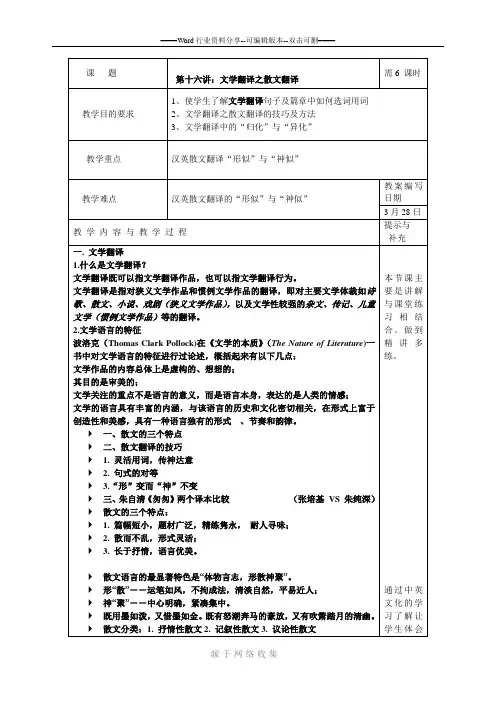
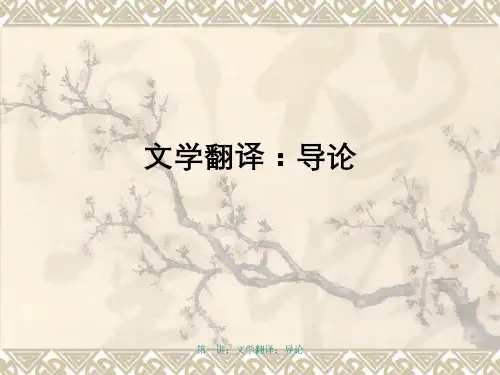
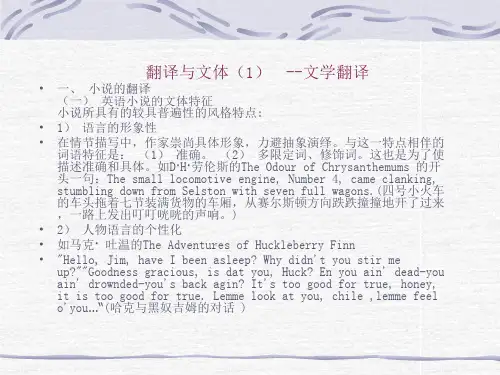
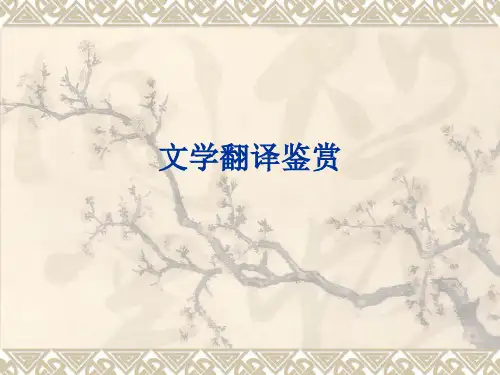

1.Those visitors wander into the church and look around aimlessly. They come out onto the village green and photograph each other in a stone armchair said to be the throne of Attila. They relentlessly tear at the wild roses which one has seen in bud and longed to see in bloom and which, for a day have scented the whole island. As soon as they are picked the roses fade and are thrown into the canal. (excerpt from Nancy Mitford’s The Water Beetle)游客们在教堂里尽情畅游,漫无目的地四处张望。
他们来到村中草地,在石扶手椅上互相拍照留影,据说这石椅曾专属于一位匈奴国王。
游客们无情地撕扯那些野玫瑰花,殊不知它们有的正含苞待放,有的正等待在未来的某一天芳香整片小岛。
这些花儿一被摘下就都枯萎了,接着又被扔进运河之中。
2.Ralph was a small man with wispy white hair and a baby-pink complexion. Behind the enormous oak desk of his library he looked like a midget. The dictionaries and thesauri stacked on either side of him added the effect of framing his face, so that he looked like a midget peering over a window sill. His usually vacant eyes were clouded with resentment. (excerpt from Leonard F. Hilts’ Murder at the Crosswords)拉尔夫是这样一位小老头:他有着稀疏的白头发,面容却似婴儿一般粉嫩可爱。

中国文学外译历程-概述说明以及解释1.引言1.1 概述中国文学外译是指将中国文学作品翻译成其他国家的语言并在国际上传播的过程。
作为中国优秀的文化遗产,中国文学拥有悠久的历史和丰富的内涵,其独特的风格和深刻的思想引起了世界各地读者的兴趣和关注。
因此,中国文学外译一直是跨越国界、加强文化交流的重要途径。
中国文学外译的起源可以追溯到古代。
早在公元后的汉朝时期,中国古代文学就开始出现译作,例如将佛教经典翻译成汉字。
而随着历史的演进,文学作品的翻译越来越多地引入了对外国文化的理解和表达,形成了独具特色的外译风格。
中国文学外译的发展历程经历了不同的阶段。
初期,中国文学外译主要集中在对佛教经典和历史文献的翻译上,这对于中国文化的传播和世界各地对中国文学的了解起到了重要的推动作用。
而到了现代,中国文学的外译范围进一步扩大,不仅包括了古代文学作品,还包括了现当代作家的小说、诗歌、戏剧等各种文学形式。
同时,随着翻译技术的不断提高和国际交流的加强,中国文学作品的外译水平也有了长足的进步。
中国文学外译的影响和意义是不可忽视的。
首先,中国文学的外译丰富了世界文学的多样性,使得国际读者能够更加全面地了解中国文化和思维方式。
其次,中国文学外译也为中国作家和文化产业带来了广阔的发展机遇,推动了中国文学在国际上的知名度和影响力的提升。
此外,中国文学外译还促进了不同文化之间的交流与碰撞,增进了世界各国人民之间的相互理解和友谊。
综上所述,中国文学外译是一个漫长而又不断发展的历程。
通过对中国文学作品的翻译和传播,中国文学外译在国际文化交流中发挥着重要作用。
然而,还需要进一步提升翻译水平和技术,加强人才培养,以更好地推动中国文学外译事业的发展,并为更多国家读者带来中国文学的魅力和智慧。
1.2文章结构文章结构部分可包括以下内容:文章结构部分旨在介绍本篇长文的组织和安排方式,以便读者能够清晰地了解文章所呈现的内容和逻辑顺序。
本文按照以下结构进行组织:1. 引言部分:介绍本文研究的背景和意义,概述中国文学外译的历程和发展。
汉英翻译考研陈宏薇《新编汉英翻译教程》考研真题一、汉英翻译考研真题一Ⅰ. 填空题1. 按照文本类型来分,翻译可分为_____、_____、_____、_____。
【答案】文学翻译;科技翻译;新闻翻译;应用文翻译@@【解析】根据书中所述,文本的类型概括起来有小说、诗歌、戏剧等文学文本,科技报告、科技论文等科技文本,新闻报道、通讯、社论、特写等新闻文本,广告、合同、产品说明书等应用文本。
2. 就翻译方式而言,主要有_____、_____、_____,其中_____是翻译最基本的方式。
【答案】全译;摘译;编译;全译@@【解析】全译,指全文翻译,为翻译最基本的方式。
摘译,指根据特定目的,选取、翻译原文的一部分,从而使译入语读者更快地获得所需源语文本中的信息。
编译为“编辑”和“翻译”的结合。
3. 汉语和英语均具有的语言层级为_____、_____、_____、_____、_____。
【答案】词;短语;句子;段落;篇章@@【解析】翻译单位是翻译研究和学习翻译不可忽视的问题,因为涉及到两种语言在什么层级上进行转换的问题。
汉英两种语言均有的语言层级为词(word)、短语(phrase)、句子(sentence)、段落(paragraph)和篇章(text)。
其中,篇章是最理想的翻译单位。
4._____是能独立运用的最小语法单位,_____是词与词组合而成的语法单位。
【答案】词;短语@@【解析】需要注意的是,由于汉英两种语言分属不同的语系,在语言文化特别是句法结构和思维模式上的差异比较大,因此以词或短语为翻译单位行不通。
5. 对于初学者来说,_____是较为理想的翻译单位。
【答案】句子@@【解析】句子可以表达完整的意思,可以通过语调来表示陈述、疑问、感叹等语气,同时句子末段会有显著的停顿符号。
这些使得汉语中的句子比较容易辨识,容易分析,在翻译时较容易转变句子结构,使译文符合英文的句子结构。
因此,对于初学者来说,与词、短语或篇章相比,句子是更为理想的翻译单位。
2008年11月第24卷 第6期Journal of Sichuan I nternati onal Studies UniversityNov.,2008 Vol.24 No.6第三类翻译与第三种文化———文学翻译与文化异质的传送段 峰(四川大学外国语学院,四川成都 610064)提 要:文学翻译亦是文化翻译。
翻译是源语文化与译语文化的共同行为,译著是源语文化与译语文化相互作用的结果。
翻译改造了文化异质,同时又保持了文化异质。
翻译所展示的文化既不是彻底的源语文化,也不是彻底的译语文化,而是一种具有本土化的异质文化,一种让读者既熟悉又陌生的文化。
关键词:文学翻译;文化翻译;文化异质;本土化中图分类号:H31519 文献标识码:A 文章编号:1003-3831(2008)06-0084-04The Th i rd Type of Tran sl a ti on and The Th i rd Type of Culture:L iterary Tran sl a ti on and The Tran s m issi on of Cultura l Heterogene ityDUAN FengAbstract:L iterary translati on is in its real sense the cultural translati on.Translati on is the p r ocess in which the s ource cul2 ture and the target culture interact with each other and the translated work is the result of the interacti on.Translati on dis2 p lays neither the comp lete s ource culture nor the comp lete target culture but a l ocalized culture with heter ogeneity,one both fa m iliar and strange t o its target readers.Key words:literary translati on;cultural translati on;cultural heter ogeneity;l ocalizati on 1.文学翻译与“歌德模式”跨文化交流表现为不同的文化在一定的文化共性之上的文化相异性的对话和碰撞,它的最终目的是促进不同文化之间的相互理解和交流;要达到这个目的,展示文化间的共性和个性,尤其是后者,是跨文化交流的主要任务。
203作者简介:王功菊(1976— ),女,汉族,安徽金寨人。
主要研究方向:文学翻译。
道安,他提出来的“三不易”理论,通过经验总结和理性归纳,涉及诸多现代翻译学理论要素,如句法、修辞、文体、受众、时空、主体性等,为我们现代翻译提供了参考价值。
一、“三不易”在文学翻译理论中的体现在19世纪时期,很多诗人翻译与创作的界限都非常模糊,“译作合一”的倾向普遍存在,“由惊喜而摹仿,由摩仿而创造”。
19世纪到20世纪,中国历史进入了现代,翻译的重要性突显出来。
中国新文学的兴起同翻译是分不开的。
第一个重视翻译并大力加以倡导的人是鲁迅。
他主张直译。
这样做的目的是:在介绍外国思想以供借鉴的同时,还要通过译文改造我们的语言。
而“三不易”中第二条说的是原文中千年之前的圣人之言立意高远,要把其中所蕴含的丰富含义传递给浅俗大众,殊为不易。
其中也阐述了佛经翻译的主要目的是把充满智慧的禅意转化为通俗易懂的语言,使其对劳苦大众有一定的启发和超脱作用[1]。
林语堂提出了翻译的三条标准:第一是忠实标准,第二是通顺标准,第三是美的标准。
[2]他从另一角度将这三重标准说成是译者的三种责任:译者对原著者的责任、对中国读者的责任以及对艺术的责任。
他说“三样的责任心备,然后可以谓具有真正翻译家的资格。
”[3]这些翻译思想和理论无论是“标准说”还是“责任说”都与“三不易”所表达的思想基本一致。
谈到现代翻译,在这里不得不说一下杨绛先生。
杨绛先生把翻译或翻译者或翻译工作比喻成仆人,她认为翻译者一切得听从主人,不能自作主张。
而且一仆二主,同时伺候着两个主人:一是原著,二是译文的读者。
译者一方面得彻底了解原著;不仅了解字句的意义,还须领会字句之间的含蕴,字句之外的语气声调。
译者须对原著彻底了解,方才能够贴合着原文,照模照样地向读者表达。
可是尽管了解彻底,未必就能照样表达。
彻底理解不易,贴合着原著照模照样地表达更难。
好一个“彻底理解不易,贴合原著照模照样地表达更难”。
《英汉互译》教案与讲义教案章节一:英汉互译概述教学目标:1. 了解英汉互译的基本概念和原则。
2. 掌握英汉互译的基本技巧和方法。
3. 能够进行简单的英汉互译实践。
教学内容:1. 英汉互译的概念和定义。
2. 英汉互译的原则和标准。
3. 英汉互译的基本技巧和方法。
4. 英汉互译的实践案例分析。
教学活动:1. 引入英汉互译的概念和定义。
2. 讲解英汉互译的原则和标准。
3. 介绍英汉互译的基本技巧和方法。
4. 提供实践案例,让学生进行翻译练习。
教学评价:1. 学生能够回答英汉互译的概念和定义。
2. 学生能够理解英汉互译的原则和标准。
3. 学生能够掌握英汉互译的基本技巧和方法。
4. 学生能够进行简单的英汉互译实践。
教案章节二:词汇与翻译1. 了解词汇在英汉互译中的重要性。
2. 掌握英汉词汇的差异和转换方法。
3. 能够准确翻译词汇和短语。
教学内容:1. 词汇在英汉互译中的作用和重要性。
2. 英汉词汇的差异和转换方法。
3. 常见词汇和短语的翻译实例。
教学活动:1. 引入词汇在英汉互译中的作用和重要性。
2. 讲解英汉词汇的差异和转换方法。
3. 提供常见词汇和短语的翻译实例。
4. 让学生进行词汇翻译练习。
教学评价:1. 学生能够理解词汇在英汉互译中的重要性。
2. 学生能够掌握英汉词汇的差异和转换方法。
3. 学生能够准确翻译常见词汇和短语。
教案章节三:语法与翻译教学目标:1. 了解语法在英汉互译中的重要性。
2. 掌握英汉语法的差异和转换方法。
3. 能够正确翻译句子和段落。
1. 语法在英汉互译中的作用和重要性。
2. 英汉语法的差异和转换方法。
3. 常见语法错误的分析和纠正。
教学活动:1. 引入语法在英汉互译中的作用和重要性。
2. 讲解英汉语法的差异和转换方法。
3. 提供常见语法错误的分析和纠正。
4. 让学生进行句子和段落的翻译练习。
教学评价:1. 学生能够理解语法在英汉互译中的重要性。
2. 学生能够掌握英汉语法的差异和转换方法。
<Break, Break, Break> the death of his best friend, his sadness feeling are contrasted with the carefree, innocent joys of the children and the unfeeling movement of the ship and the sea waves《溅吧、溅吧、溅吧》,最好的朋友的早逝, 少年的无忧无虑、天真快乐,海浪和船只的无情移动与诗人心境的悲伤作对比<Crossing the Bar> we can feel his fearlessness towards death, his faith in God and an afterlife. ’Crossing the bar’ means leaving this world and entering the next world《渡过沙洲》我们可以感受到他对死亡的无畏,他对上帝以及来世的忠实信仰,“渡过沙洲”意味着离开这个世界进入到另一个世界<Ulysses> not endure the peaceful commonplace everyday life, old as he is, he persuades his old followers to go with him and to set sail again to pursue a new world and new knowledge, dramatic monologue,《尤利西斯》不能忍受平凡宁静的生活,即使他老了,他还是说服他的老追随者同他一起,再次出航,追求新世界,新知识,戏剧独白Robert Browning - the most original poet, who improve and mature the dramatic monologue罗伯特·勃朗宁-最早提高并且使喜剧独白走向成熟的诗人<The Ring and the Book> his masterpiece他的杰作《环与图书》<My Last Duchess> this dramatic monologue is the duke’s speech addressed to the agent who comes to negotiate the marriage, the duke is a self-conceited, cruel and tyrannical man《我的前公爵夫人》这个戏剧性的独白,是公爵与前来提亲的代理人之间的对话,公爵是一个自负,残暴和专制的人<Meeting at Night> 夜会<Parting at Morning>晨别George Eliot:As a woman of exceptional 特有的intelligence and life experience, she shows a particular concern for the destiny of women乔治.艾略特:一个有着异常智慧和生活经验的妇女,她表达了自己对妇女命运的特别关注<Middlemarch> a sharp contrast is set between the cold, lifeless, dull house and Dorothea who is full of youthful life and vigor《米德尔马契》将精力旺盛、活力四射的多萝西娅与凄冷、毫无生气、阴暗的房子形成强烈对比Thomas Hardy - both a naturalistic and a critical realist writerLocal-colored, Wessex, ’novels of character and environment’托马斯·哈代-既是一个自然主义作家,也是一个批判现实主义作家,他的作品带有地方乡土色彩,艾塞克斯-小说的背景及特征<Tess of the D’Urbervilles> experience is as to i ntensity, and not as to duration 《德伯家的苔丝》的经验是与其容忍,不如反抗American Romantic Period 美国浪漫主义时期Started with Washington Irving’s <The Sketch Book> and ended with Whitman’s <Leaves of Grass>, also called ’the American Renaissance’Free expression of emotion, escapes from society, and return to nature New England Transcendentalism以华盛顿欧文的《见闻杂记》开始,以惠特曼的《草叶集》结束。
第二部分翻译方法第三章如何正确选择词义在文学翻译过程中,针对原文的词义正确地选择汉语词义,是保证译文质量的根本一环。
首先一个词在不同的句子中有不同的含义。
1)T h i s g e n e r a l w a s c h a r g e d w i t h t r e a s o n.这个将军被指控犯了叛国罪。
2)T h e C o m m i t t e e d e c i d e d t o p u t P r o f e s s o r H e n r y i n c h a r g e o f t h e r e s e a r c h w o r k.委员会决定让亨利教授负责这项研究工作。
类似短语有t a k e c h a r g e o f,t a k e c h a r g e译为“负责”3)A s s o o n a s t h e m o m e n t f o r t h e g e n e r a l o f f e n s i v e a r r i v e d,t h e s o l d i e r s c h a r g e d t h e e n e m y p o s i t i o n b r a v e l y.总攻时间一到,战士们勇猛地向敌人的阵地冲去。
4)S h e c o m p l a i n e d t h a t s h e h a d b e e n c h a r g e d t o o m u c h.她抱怨说,向她收的费太高了。
5)T h e p o w d e r i n p l a c e,h e r a m m e d i n a l o n g i r o n r o d t o t a m p d o w n t h e c h a r g e..火药装好后,他伸进去一根长铁钎以便把炸药捣实。
6)T h i s s t o r e w i l l c h a r g e t h i n g s y o u b u y,a n d l e t y o u p a y f o r t h e m l a t e r.这家商店将你所买的东西记入账内,让你以后付款。